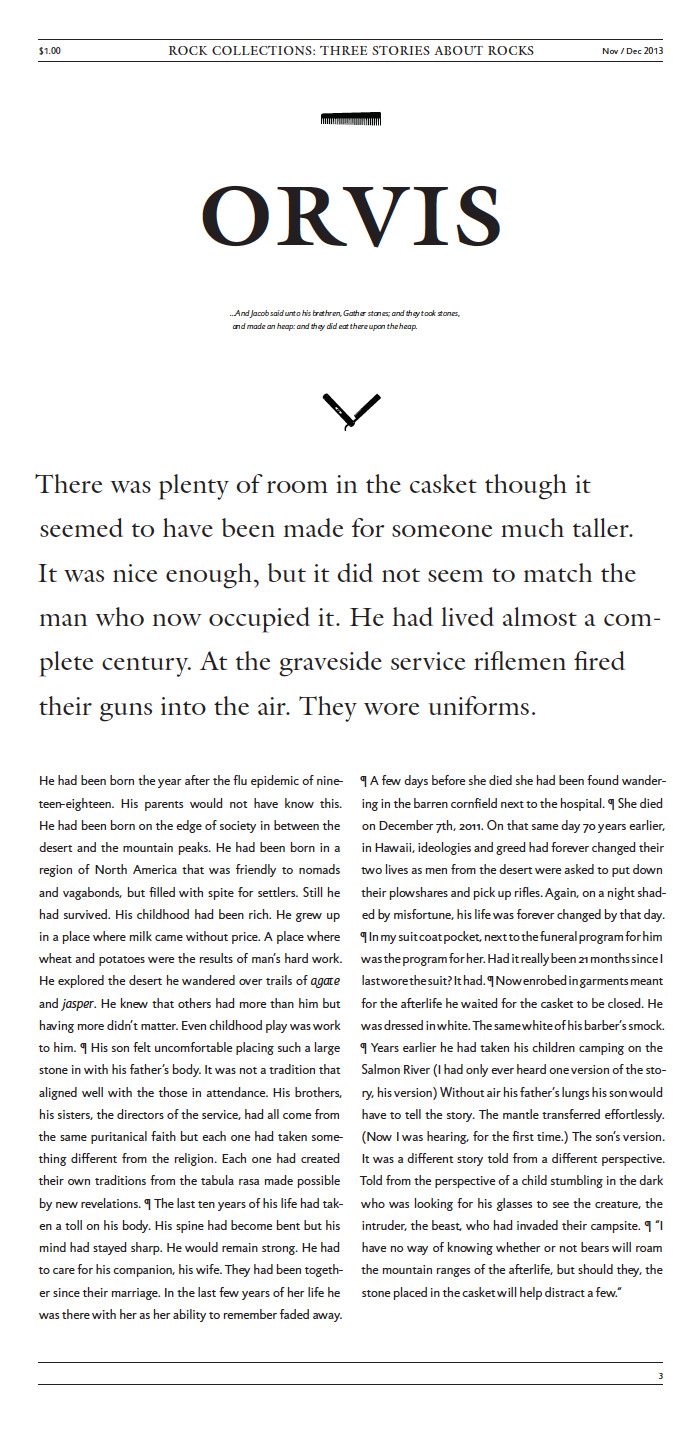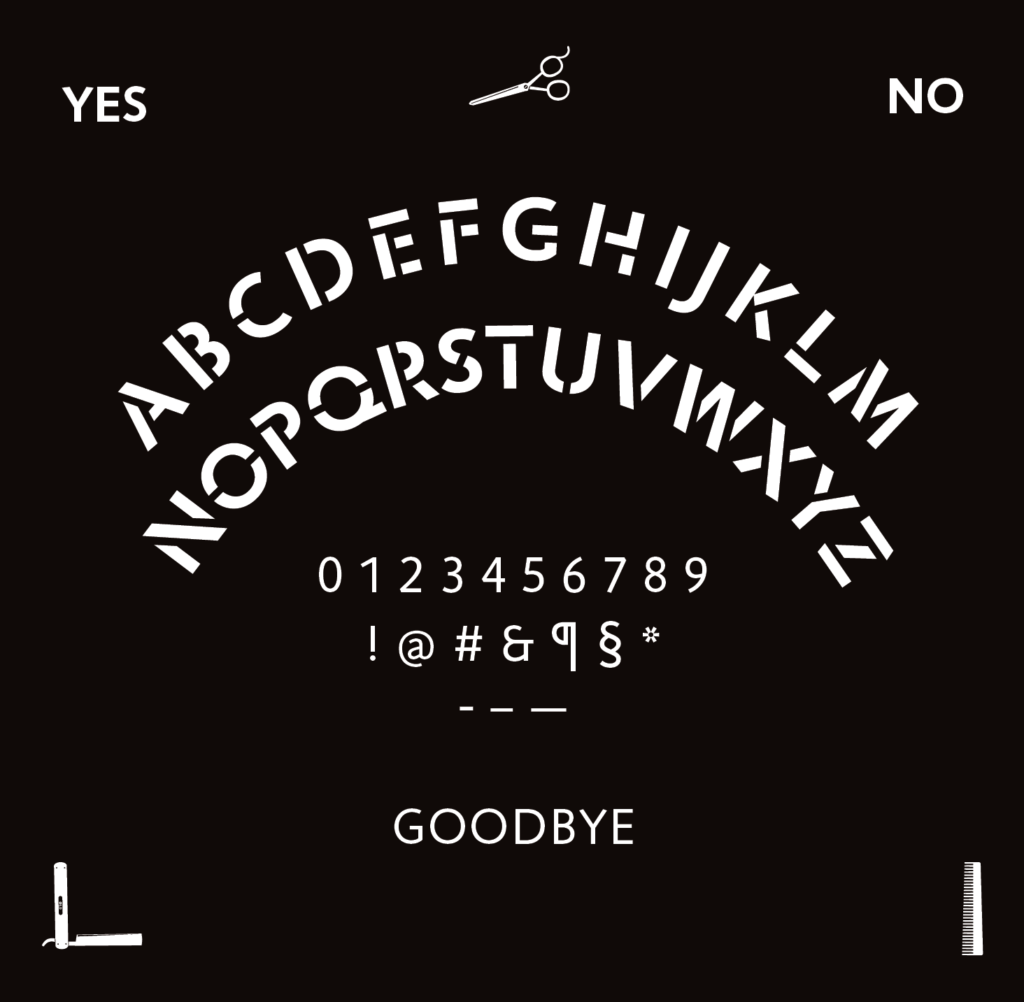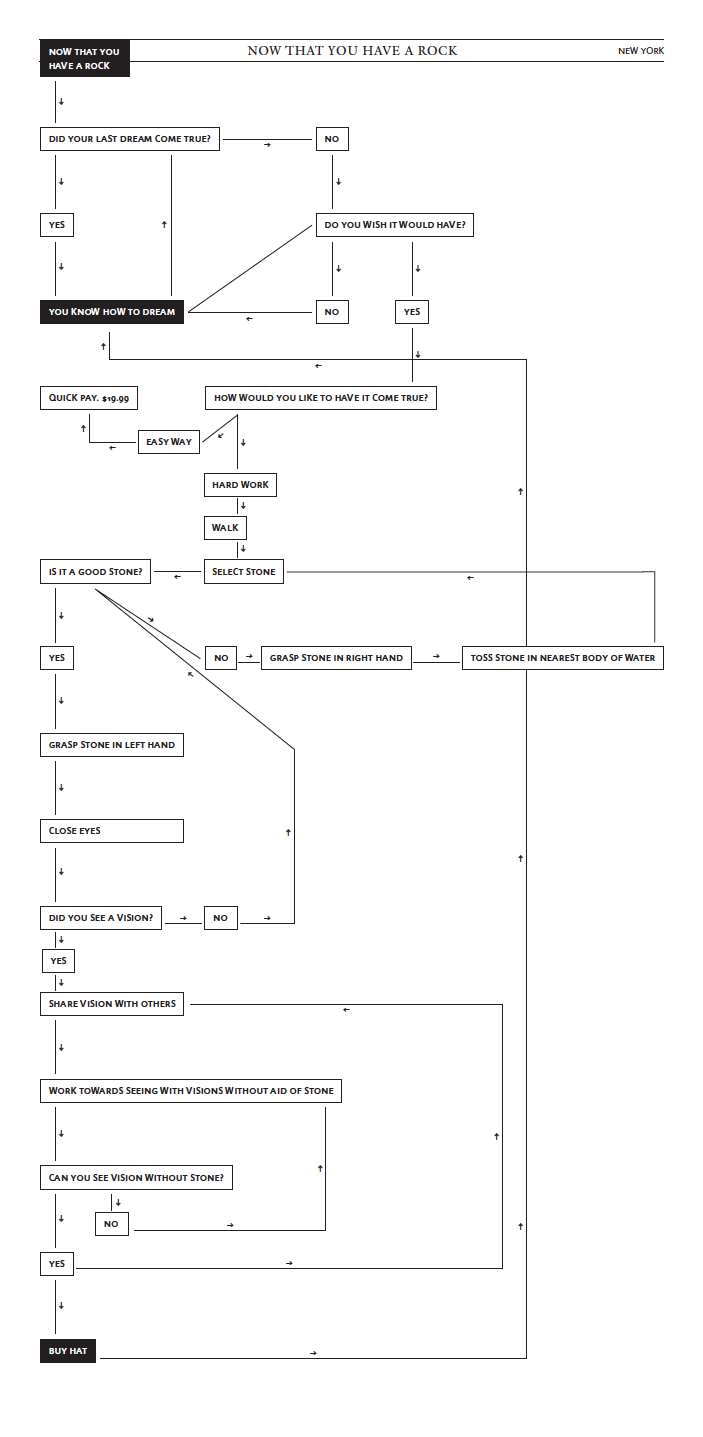Rock Collections: Three Stories About Rocks
Addendum
—————————-
By Jason Dilworth
Three Stories about Rocks was largely inspired by a road trip that I took after attending the funeral for my grandfather. The funeral happened to coincide with a government shutdown and a late fall blizzard that made it possible for me to visit the region in relative isolation. On this trip, I visited the National Parks of Grand Teton, Craters of the Moon, Fossil Butte National Monument.
For years I’ve been drawn to the human connection many feel toward rocks. We use them as markers, for tools, and building materials. These inanimate objects seem to hold sway over our actions. And even more puzzling, certain rocks seem endowed with mystical powers far beyond what is scientifically explainable.
When I made this publication I was interested in tangentially confronting some of the more far-fetched aspects of my grandfather’s Mormon faith and specifically the idea that a stone could be used as a device that aided in the translation of an ancient language.
At the time I found this idea fantastically unbelievable – a uniquely American religious colloquialism. But in light of recent developments, I realize that I had failed to see the more insidious and racists backstory of the seer stone.

A note on Mormon beliefs.
Mormons, who prefer to be called members of the church of Jesus Christ of Latter-day Saints, received their nickname from a book written by their church’s founder Joseph Smith. Smith claimed that through divine and angelic visitations he had come into possession of a record of ancient Christians and that they had over centuries recorded their history into codices assembled from pages of precious metals. Smith told the tale of a group of people who left the middle east and traveled to North America and then divided into two groups, the righteous and the wicked. In Smith’s story, God curses the wicked group with dark skin1 while blessing the devout by allowing them to keep their fair complexion and become a “white and delightsome people2”. As the stories of the Book of Mormon unfolds these two separate societies co-exists in various cycles of war and peace but ultimately the dark-skinned people exterminate all of the light-skinned people and their descendants go on to become native people of both North and South America3. This story is laid out in the introduction of the book and was used by Mormons to justify their occupation and settlement of Native lands as the fulfillment of a divine prophecy.
The story is so overtly racists that it is hard to believe that it was able to get as much traction as it has over time. I imagine they were able to do so for many reasons including the fact that America itself is founded on racists principles. Moreover, theologically Mormons have been given a wide berth because of an abundance of heretical beliefs, not the least of which was its early and continued practice and support of polygamy4.

A note on how Joseph Smith allegedly translated the book of Mormon from, his words, “Reformed Egyptian5” into King James era English.
It is easy to mock beliefs that are different from your own. From a distance, most religious tales sound comical and harmless. Initially, I found the idea of the seer stone to be a novel idea. Harmless. That was until late 2017 when I realized the racism within Mormonism wasn’t just a dusty anachronism but has been influential in perpetuating and rationalizing the continued colonization and desecration of native lands
Utah and Mormonism are inseparable; you cannot mention one without conjuring the other. However, the word Utah itself is derived from the Native People who lived there for thousands of years before the Mormons arrived in 1847.
As is typical with the western expansion of the United States the occupation of native lands resulted in conflict and violence and the erasure of history. In Utah, this conflict continues today6. And is most recently seen through the creation and subsequent shrinking of the Bears Ears National Monument. In the buildup to Trump’s decision to shrink Bears Ears we saw Utah’s most famous politician Orrin Hatch champion legislation veiled as support for the rural ranchers of San Juan County7. This legislation, however, has always really been a way to favor white settlers over native people. Through the political rise of Donald Trump Hatch’s cohort found a racist-in-chief who would be sympathetic to their views and would be capable of delivering a devastating blow to native rights.

How this relates to the small stone Joseph Smith used to create a religion.
In 2014 the Church of Jesus Christ of Latter-Day Saints working with historians and researchers published the Joseph Smith Papers8 – a collection of documents and artifacts from the early days of the Church. Included in these papers was an image of the seer stone, an artifact that few Mormons had ever seen or even heard about. As an object it is rather humble, a small dark stone housed in a leather pouch9. Many Mormons I talked with were somewhat disappointed by its unimpressive aesthetics. But to others more trained in object recognition, it raised more questions. The object had all the signs of an auspicious amulet worn by native people10 from the northeast. Native groups are now calling for the reparation of the artifact, but have so far been ignored by LDS Church Leadership.
In December of 2017 when Donald Trump visited Utah to announce his plan to shrink Bears Ears I had secretly hoped that the church would take a stand and denounce the action. That it would call for cooler heads and would find solidarity with the native religious leaders who were asking for the protection of sacred sites located within the original monument boundaries. The opposite happened11. After declaring that he was ordering that the monument be shrunk the Mormon leadership jocularly12 took Trump on a tour their offices and headquarters proving that like Donald Trump they were cut from the same racist cloth13.
Further Reading and Resources
Introduction to the Book of Mormon
Rejecting Racism
The Joseph Smith Papers Image of Seer Stone
Home of The Brave Bears Ears